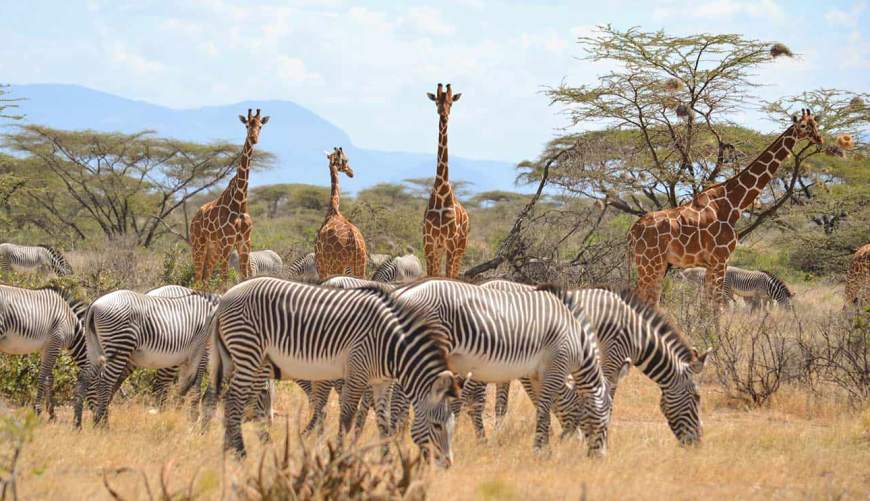Shaba National Reserve
Shaba National Reserve is a lesser-known gem located in northern Kenya, part of the greater Samburu ecosystem. It covers an area of 239 square kilometers and is adjacent to the more famous Samburu and Buffalo Springs reserves. The reserve is named after Mount Shaba, a dormant volcano that dominates the landscape. Its rugged and remote location gives it a distinctive wilderness feel, making it perfect for travelers seeking a quiet and intimate safari experience. The reserve was made famous by the renowned conservationist Joy Adamson, who chose Shaba as the location for her wildlife rehabilitation efforts. Shaba is part of the area where the famous lioness Elsa, from the book and movie Born Free, was raised and released into the wild. Shaba’s landscapes are a mix of semi-arid plains, volcanic formations, and riverine forests that make it stand out from other reserves.

Scenery
Shaba National Reserve is known for its dramatic and rugged landscape. The reserve’s most notable feature is Mount Shaba, a volcanic mountain that provides a stunning backdrop to the savannah plains. The reserve’s terrain is characterized by rocky outcrops, volcanic hills, and expansive acacia woodlands. The riverine areas along the Ewaso Ng’iro River are lush with vegetation, including palm groves and acacia trees, which create a striking contrast with the dry, semi-arid plains of the reserve. The winding river provides a source of water for both wildlife and vegetation, making it the focal point for animal activity in the park. The dramatic views of the rolling plains, dotted with wildlife, against the volcanic backdrop create a picturesque and tranquil atmosphere.
Wildlife
Shaba National Reserve is home to a wide range of wildlife, including some species that are unique to northern Kenya. Among the most prominent residents are the Samburu Special Five, which includes the Grevy’s zebra, reticulated giraffe, Beisa oryx, Gerenuk, and Somali ostrich. These species are adapted to the arid environment and are rarely seen in other parts of Kenya. The reserve is also home to larger mammals such as lions, leopards, cheetahs, buffalos, and elephants, which can often be seen along the banks of the Ewaso Ng’iro River, the lifeline of the reserve.
Shaba’s less touristy nature means that visitors have a higher chance of witnessing wildlife in a peaceful and undisturbed setting. Additionally, the rare striped hyena and aardwolf can be spotted in the reserve, adding to its unique wildlife offering. The presence of crocodiles and hippos in the Ewaso Ng’iro River is another attraction for wildlife enthusiasts.
Birds in Shaba National Reserve
Shaba National Reserve is a birdwatcher’s paradise, with over 450 bird species recorded in the area. Its unique northern location makes it home to several species that are not typically found in other parts of Kenya. The riverine habitats and acacia woodlands attract a wide range of bird species, including the Somali ostrich, vulturine guineafowl, Taita falcon, and yellow-throated sandgrouse.
The reserve is also known for its raptors, with species such as the martial eagle, Verreaux’s eagle, and the pale chanting goshawk frequently spotted. Waterbirds are commonly found along the riverbanks, including herons, kingfishers, and ibises. Migratory birds also make Shaba a temporary home, especially between November and April, making this an excellent time for birdwatching.
Weather and Climate
Shaba National Reserve has a semi-arid climate with hot temperatures and minimal rainfall throughout the year. The area experiences two distinct rainy seasons: the long rains from March to May and the short rains from October to December. The dry seasons, from June to September and January to February, are the best times to visit the reserve, as the vegetation is sparse and animals are easier to spot around water sources. During the dry season, daytime temperatures can rise to around 30°C to 35°C (86°F to 95°F), while nights are cooler. In the rainy season, the reserve is lush and green, although some roads may become impassable. Light clothing and sun protection are recommended, given the hot, sunny climate.
How To Get To Shaba National Reserve
Shaba National Reserve is accessible by both road and air. By road, it is about 314 kilometers (195 miles) from Nairobi, and the journey takes around 5 to 6 hours. The most common route is via the Isiolo-Marsabit road, which is well-maintained. However, a 4×4 vehicle is recommended for exploring the reserve, especially during the rainy season when some roads may be muddy.
For air travel, there are scheduled flights from Wilson Airport in Nairobi to Samburu Oryx airstrip, which serves both Samburu, Buffalo Springs, and Shaba reserves. The flight takes about 1 hour. From the airstrip, visitors can arrange transfers to their lodges or camps in Shaba.
Activities to Engage in Shaba National Reserve
Shaba National Reserve offers a variety of activities that allow visitors to immerse themselves in the natural beauty and wildlife of the area:
- Game Drives: The primary activity in Shaba is game driving, which offers opportunities to spot the Samburu Special Five, big cats, elephants, and other wildlife. Early morning and late afternoon game drives are the best times to view animals when they are most active.
- Bird Watching: Shaba is an excellent destination for bird lovers, with a wide range of species to observe, particularly along the river and in the wooded areas.
- Guided Nature Walks: Take a guided walk with an experienced ranger to learn more about the flora and fauna of the area. These walks provide a more intimate exploration of the reserve’s landscapes and smaller wildlife.
- Cultural Visits: Visitors can engage with the local Samburu people, learning about their traditional way of life and unique culture. Cultural tours often include village visits, traditional dances, and opportunities to purchase handmade crafts.
- Photography: The striking landscapes and abundant wildlife of Shaba make it a fantastic destination for photography. Capture the beauty of Mount Shaba, the Ewaso Ng’iro River, and the diverse wildlife.
Safety and Vaccination
Shaba National Reserve is a safe destination for tourists, with regular patrols by park rangers ensuring the safety of both visitors and wildlife. However, as in all wildlife areas, it’s essential to follow safety guidelines, particularly when on game drives. Visitors should stay in their vehicles unless in designated areas and always keep a safe distance from the animals. Due to the semi-arid climate, the risk of malaria is relatively low, but it’s still advisable to take antimalarials if you’re visiting other regions of Kenya where malaria is more common. Standard vaccinations such as yellow fever, typhoid, and hepatitis A are recommended. Visitors should also bring insect repellent and ensure they stay hydrated, especially in the hot, dry climate.
Shaba National Reserve Park Rules
To ensure the protection of wildlife and the safety of visitors, Shaba National Reserve enforces several rules:
- No off-road driving: Stick to designated tracks to avoid damaging the environment.
- Do not feed the animals: Feeding wildlife disrupts their natural behaviors.
- Respect the wildlife: Keep a safe distance and avoid disturbing the animals.
- No littering: Keep the reserve clean by disposing of trash responsibly.
- No loud noises: Excessive noise can disturb both the animals and other visitors.
- Follow speed limits: This helps protect the wildlife and ensures safety.
Shaba National Reserve offers a more secluded and tranquil safari experience, where visitors can connect with nature in a peaceful and stunning setting. Whether you are interested in game drives, birdwatching, or cultural experiences, Shaba is a rewarding destination that combines wildlife, scenic beauty, and rich history.
